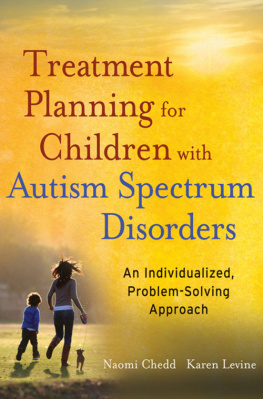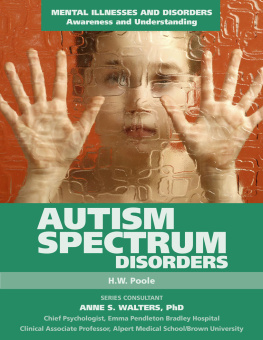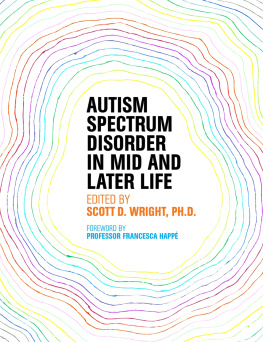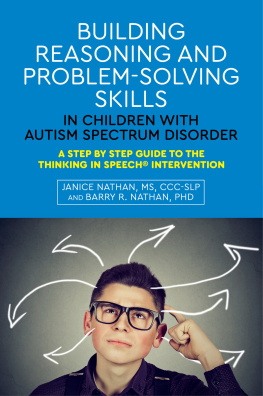
Praise for Treatment Planning for Children with Autism Spectrum Disorders: An Individualized, Problem-Solving Approach
In the complex and challenging world of Autism Spectrum Disorders, this book offers a welcome, needed and thoroughly useful approach to planning treatment, whatever the setting, resources or problems. Chedd and Levine have managed to create a guide for educators, therapists and parents that is all at once practical and relevant, insightful and thought-provoking.
Richard Bromfield, Ph.D.
Harvard Medical School
Author, Embracing Aspergers: A Primer for Parents and Professionals and Doing Therapy with Children and Adolescents with Asperger Syndrome
After introducing best practices for intervention in autism, Chedd and Levine present vivid case studies that bring alive the concept of matching methodologies and techniques to the widely diverse needs of individuals on the autism spectrum. My highest recommendation for anyone wishing to learn more about supporting those with autism.
Stephen M. Shore, Ed.D.
Assistant Professor of Special Education
Adelphi University
Co-author of Autism for Dummies and Seven Keys to Unlock Autism: Making Miracles in the Classroom
Chedd and Levine make clear the foundations of Evidence Based Practice: vetting relevant research and using clinical judgment and experience to offer clients and families a range of options so that they can choose based on their own culture, values and individual needs in a true process of informed consent. In case examples Chedd and Levine demonstrate critical aspects of comprehensive assessment and the central organizing principle of ongoing reflective efforts to adjust the course of intervention. This book drives forward the effort to offer families rational choices and responsive intervention for children with Evidence Based Practices for Autism Spectrum Disorders.
Joshua D. Feder, M.D.
Director of Research, Interdisciplinary Council on Developmental and Learning Disorders Graduate School
Service providers and parents of children with ASD are often overwhelmed and greatly stressed by the explosion of treatments for autism, and the marketing and claims of effectiveness of specific approaches. Now that declarations such as Only this approach works for children with ASD are no longer considered credible, there is an urgent need to support parents and professionals with a systematic process to guide individualized treatment planning based on evidence-based practice. Levine and Chedd have taken a huge step in meeting this need in this thought-provoking book that is both rooted in years of clinical experience and in-depth knowledge of the most current research, but exceptionally practical with intriguing case vignettes. A timely and much needed resource.
Barry M. Prizant, Ph.D., CCC-SLP
Director, Childhood Communication Services
Adjunct Professor
Center for the Study of Human Development
Brown University
Co-Author: of The SCERTS Model

Cover Design: John Wiley & Sons, Inc.
Cover Images: sky image: Andrei Radzkou/iStockphoto
people image: rami halim/iStockphoto
This book is printed on acid-free paper. 
Copyright 2013 by John Wiley & Sons, Inc. All rights reserved.
Published by John Wiley & Sons, Inc., Hoboken, New Jersey.
Published simultaneously in Canada.
No part of this publication may be reproduced, stored in a retrieval system, or transmitted in any form or by any means, electronic, mechanical, photocopying, recording, scanning, or otherwise, except as permitted under Section 107 or 108 of the 1976 United States Copyright Act, without either the prior written permission of the Publisher, or authorization through payment of the appropriate per-copy fee to the Copyright Clearance Center, Inc., 222 Rosewood Drive, Danvers, MA 01923, (978) 750-8400, fax (978) 646-8600, or on the web at www.copyright.com . Requests to the Publisher for permission should be addressed to the Permissions Department, John Wiley & Sons, Inc., 111 River Street, Hoboken, NJ 07030, (201) 748-6011, fax (201) 748-6008.
Limit of Liability/Disclaimer of Warranty: While the publisher and author have used their best efforts in preparing this book, they make no representations or warranties with respect to the accuracy or completeness of the contents of this book and specifically disclaim any implied warranties of merchantability or fitness for a particular purpose. No warranty may be created or extended by sales representatives or written sales materials. The advice and strategies contained herein may not be suitable for your situation. You should consult with a professional where appropriate. Neither the publisher nor author shall be liable for any loss of profit or any other commercial damages, including but not limited to special, incidental, consequential, or other damages.
This publication is designed to provide accurate and authoritative information in regard to the subject matter covered. It is sold with the understanding that the publisher is not engaged in rendering professional services. If legal, accounting, medical, psychological or any other expert assistance is required, the services of a competent professional person should be sought.
Designations used by companies to distinguish their products are often claimed as trademarks. In all instances where John Wiley & Sons, Inc. is aware of a claim, the product names appear in initial capital or all capital letters. Readers, however, should contact the appropriate companies for more complete information regarding trademarks and registration.
For general information on our other products and services please contact our Customer Care Department within the United States at (800) 762-2974, outside the United States at (317)572-3993or fax (317) 572-4002.
Wiley publishes in a variety of print and electronic formats and by print-on-demand. Some material included with standard print versions of this book may not be included in e-books or in print-on-demand. If this book refers to media such as a CD or DVD that is not included in the version you purchased, you may download this material at http://booksupport.wiley.com. For more information about Wiley products, visit www.wiley.com .
Library of Congress Cataloging-in-Publication Data:
Chedd, Naomi, 1952
Treatment planning for children with autism spectrum disorders : an individualized, problem-solving approach/Naomi Chedd, Karen Levine.
p. cm.
Includes bibliographical references and index.
ISBN 978-0-470-88223-8 (pbk.); ISBN 978-1-118-25944-3 (ebk.);
ISBN 978-1-118-23482-2 (ebk.); ISBN 978-1-118-22106-8 (ebk.)
1. Autism in childrenTreatment. I. Levine, Karen, 1959- II. Title.
RJ506.A9C4424 2013
618.9285882dc23
2012017191
DEDICATION
For Graham, Harry, Kinsey, and Adam and in memory of my mother.
N.C.
For David, Sue, Dan, Tim, Maureen, Seth, Kelsey, Brendon, and Rebekah.
K. L.
PREFACE
Treatment planning for children with autism spectrum disorders (ASD) requires educators and therapists to have a combination of big hearts filled with an appreciation for diverse and complex children, as well as keen and flexible minds that are able to make sense of confusing, sometimes conflicting, and ever-evolving clinical and research fields. How can this child be helped today with this problem or developmental challenge? This is the question those designing and implementing treatment plans need to answer. An approach to thinking about how to answer that question is what this book is about.
Next page















